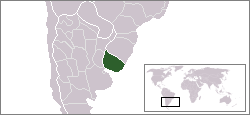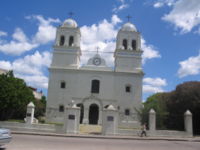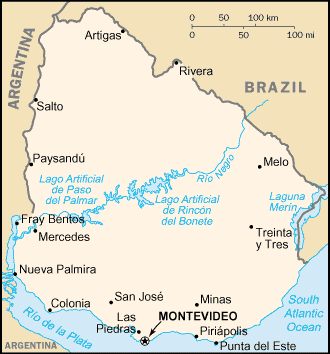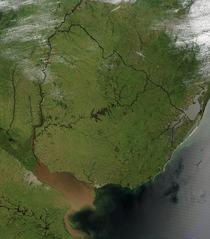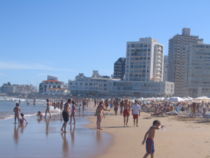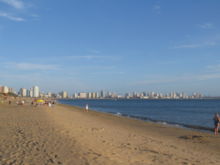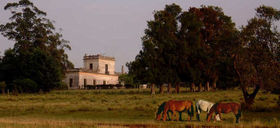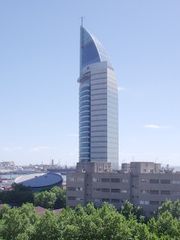Uruguay
2007 Schools Wikipedia Selection. Related subjects: Central & South American Countries; Countries
| República Oriental del Uruguay Eastern Republic of Uruguay |
|||||
|
|||||
| Motto: Libertad o Muerte (Spanish for "Liberty or Death") |
|||||
| Anthem: Orientales, la Patria o la tumba | |||||
| Capital (and largest city) |
Montevideo |
||||
| Official languages | Spanish | ||||
|---|---|---|---|---|---|
| Government | Democratic Republic | ||||
| - President | Tabaré Vázquez | ||||
| Independence | from Brazil | ||||
| - Declared | August 25, 1825 | ||||
| - Recognised | August 28, 1828 | ||||
| Area | |||||
| - Total | 176,220 km² ( 90th) 68,038 sq mi |
||||
| - Water (%) | 1.5 | ||||
| Population | |||||
| - 2005 estimate | 3,415,920 ( 128th) | ||||
| - 2002 census | 3,399,237 | ||||
| - Density | 19/km² ( 156th) 50/sq mi |
||||
| GDP ( PPP) | 2005 estimate | ||||
| - Total | $32,885 million ( 90th) | ||||
| - Per capita | $9,619 ( 67th) | ||||
| HDI (2003) | 0.840 (high) ( 46th) | ||||
| Currency | Uruguayan Peso ( UYU) |
||||
| Time zone | UST ( UTC-3) | ||||
| - Summer ( DST) | UDST ( UTC-2) | ||||
| Internet TLD | .uy | ||||
| Calling code | +598 | ||||
Uruguay, officially the Eastern Republic of Uruguay or the Republic East of the Uruguay (River) (Spanish: República Oriental del Uruguay; pron. IPA [re'puβ̞lika oɾjen'tal del uɾu'ɰwaj]), is a nation located in southern part of South America. It is bordered by Brazil to the north, the Uruguay River to the west, the estuary of the Río de la Plata (literally "River of Silver", but commonly known in English as "River Plate") to the southwest, with Argentina on the other bank of both, and finally the South Atlantic Ocean to the southeast. About half of its people live in the capital and largest city, Montevideo. The nation is the second smallest independent country in South America, larger only than Suriname (it is also larger than French Guiana, which is not independent), and is the most politically and economically stable. It was once dominated by Brazil and Portugal. On August 25, 1825, José Gervasio Artigas, led the fight for independence and that is now the national holiday.
History
The name "Uruguay" comes from Guaraní. It has many possible meanings since Guaraní is a highly agglutinative language. Two of them are "river of the urus" (uru is a kind of bird) and "river of colorful or 'painted' birds."
Politics
Politics of Uruguay takes place in a framework of a presidential representative democratic republic, whereby the President of Uruguay is both head of state and head of government, and of a pluriform multi-party system. Executive power is exercised by the government. Legislative power is vested in both the government and the two chambers of the General Assembly of Uruguay. The Judiciary is independent of the executive and the legislature. For most of Uruguay's history, the Colorado and National parties have alternated in power. The elections of 2004, however, brought the Encuentro Progresista-Frente Amplio-Nueva Mayoría, a coalition of socialists,former Tupamaros, communists and social democrats among others to power with majorities in both houses of parliament and the election of President Tabaré Vázquez Rosas by an absolute majority.
Administrative divisions
Uruguay consists of 19 departments (departamentos, singular - ''departamento):
| Department | Area (km²) 177 220 | Population (2004) | Capital |
|---|---|---|---|
| Artigas | 11,928 | 78,019 | Artigas |
| Canelones | 4,536 | 485,028 | Canelones |
| Cerro Largo | 13,648 | 86,564 | Melo |
| Colonia | 6,106 | 119,266 | Colonia del Sacramento |
| Durazno | 11,643 | 58,859 | Durazno |
| Flores | 5,144 | 25,104 | Trinidad |
| Florida | 10,417 | 68,181 | Florida |
| Lavalleja | 10,016 | 60,925 | Minas |
| Maldonado | 4,793 | 140,192 | Maldonado |
| Montevideo | 530 | 1,326,064 | Montevideo |
| Paysandú | 13,922 | 113,244 | Paysandú |
| Río Negro | 9,282 | 53,989 | Fray Bentos |
| Rivera | 9,370 | 104,921 | Rivera |
| Rocha | 10,551 | 69,937 | Rocha |
| Salto | 14,163 | 123,120 | Salto |
| San José | 4,992 | 103,104 | San José de Mayo |
| Soriano | 9,008 | 84,563 | Mercedes |
| Tacuarembó | 15,438 | 90,489 | Tacuarembó |
| Treinta y Tres | 9,676 | 49,318 | Treinta y Tres |
Geography
At 176.220 square kilometres, Uruguay is the second smallest sovereign nation in South America, after Suriname, and the third smallest political entity (French Guiana is the smallest). The landscape features mostly rolling plains and low hill ranges (cuchillas) with fertile coastal lowland, most of it grassland, ideal for cattle and sheep raising. The highest point in the country is the Cerro Catedral at 514 metres (1,686 ft). To the southwest is the Río de la Plata (River of Silver), the estuary of the Uruguay River, which forms the western border, and the Paraná River, that does not run through Uruguay itself. The only other major river is the Río Negro. Several lagoons are found along the Atlantic coast.
The climate in Uruguay is temperate, but fairly warm, as freezing temperatures are almost unknown. The predominantly flat landscape is also somewhat vulnerable to rapid changes from weather fronts, as well as to the pampero, a chilly and occasionally violent wind blowing north from the pampas plains in Argentina.
Enclaves and Exclaves
There is one Argentine enclave within Uruguayan territory: the island of Martín García (coordinates ). It is situated near the confluence of the Paraná and Uruguay rivers, a mere kilometre (1,100 yd) inside Uruguayan waters, about 3.5 kilometres (2.2 mi) from the Uruguayan coastline, near the small city of Martín Chico (itself about halfway between Nueva Palmira and Colonia).
An agreement reached by Argentina and Uruguay in 1973 reaffirmed Argentine jurisdiction over the island, ending a century-old dispute between the two countries. According to the terms of the agreement, Martín García is to be devoted exclusively to a natural preserve. Its area is about 2 square kilometres (500 acres), and the population about 200 persons. In addition, Gloria Recoda has exclusive land rights on a quarter of the island.
Economy


Uruguay's economy is characterised by an export-oriented agricultural sector, a well-educated workforce, and high levels of social spending, as well as a developed industrial sector. After averaging growth of 5% annually in 1996- 1998, in 1999- 2001 the economy suffered from lower demand in Argentina and Brazil, which together account for nearly half of Uruguay's exports. Despite the severity of the trade shocks, Uruguay's financial indicators remained more stable than those of its neighbours, a reflection of its solid reputation among investors and its investment-grade sovereign bond rating — one of only two in South America. In recent years Uruguay has shifted most of its energy into developing the commercial use of IT technologies and has become an important exporter of software in Latin America.
While some parts of the economy appeared to be resilient, the downturn had a far more severe impact on Uruguayan citizens, as unemployment levels rose to more than twenty percent, real wages fell, the peso was devalued, and the percentage of Uruguayans in poverty reached almost 10%. These worsening economic conditions played a part in turning public opinion against the free market economic policies adopted by the previous administrations in the 1990s, leading to popular rejection of proposals for privatization of the state petroleum company in 2003 and of the state water company in 2004. The newly elected Frente Amplio government, while pledging to continue payments on Uruguay's external debt, has also promised to undertake a crash jobs programs to attack the widespread problems of poverty and unemployment.
Agriculture
Agriculture played such an important part in Uruguayan history and national identity until the middle of the 20th century that the entire country was then sometimes likened to a single huge estancia (agricultural estate) with Montevideo, where the wealth generated in the hinterland was spent, as its casco or administrative head. As another saying went, "Uruguay es la vaca y el puerto" ("Uruguay is the cow and the port").
Today, agriculture still contributes roughly 10% to the country’s GDP and is the main foreign exchange earner, putting Uruguay in line with other agricultural exporters like Brazil, Canada and New Zealand. Uruguay is a member of the Cairns Group of exporters of agricultural products. Uruguay’s agriculture has relatively low inputs of labour, technology and capital in comparison with other such countries, which results in comparatively lower yields per hectare but also open the door for Uruguay to market its products as "natural" or "ecological."
Campaigns like “Uruguayan grass-fed beef” and “Uruguay Natural” aim to establish Uruguay as a premium brand in beef, wine and other food products.
Recently, an industry has arisen around estancia tourism that capitalizes on the traditional or folkloristic connotations associated with gaucho culture and the remaining resources of the historic estancias of Uruguay's golden era.
Demographics
Like the neighbouring nation of Argentina, Uruguay is heavily populated by people of European origin. 97% of the population is of white European descent almost evenly split amongst Italians, Spaniards, followed by those of English, French, German, Portuguese, Irish, Russian, Scandinavian and Armenian origins. Church and state are officially separated. Most Uruguayans adhere to the Roman Catholic faith (66%), with smaller Protestant (2%) and Jewish and Armenian Christian (1%) communities, as well as a large nonprofessing group (31%).
Uruguay is distinguished by its high literacy rate (99%), large urban middle class, and relatively even income distribution. During the 1970s and 1980s, an estimated 600,000 Uruguayans emigrated, principally to Spain, Argentina and Brazil. Other Uruguayans went to various countries in Europe and USA.
As a result of the low birth rate, high life expectancy, and relatively high rate of emigration of younger people, Uruguay's population is quite mature. In 2006 the country had a birth rate of 13.91 births per thousand population, lower than neighboring countries Argentina (16.73 births/1000 population) and Brazil (16.56 births/1,000 population).
Culture
Montevideo is considered the most pleasant capital city in the region and the country's 3.3m people - mainly of European descent - are among the best-educated and longest-living in Latin America. Poverty levels, although rising, are easily the lowest in the region and the country has the most even distribution of wealth in Latin America. Although its 20th-century history comes with the usual quota of despotic dictators, violence, corruption and economic upheaval, for about the last 25 years Uruguay has been a model of institutional integrity and fiscal responsibility - the opposite, some may argue, of the behaviour seen across the River Plate in Argentina.
- Music of Uruguay
- List of Uruguayans
Uruguayan writers
- José Enrique Rodó, essayist and thinker.
- Florencio Sánchez, playwright.
- Horacio Quiroga, short-story writer.
- Juana de Ibarbourou, poet.
- Maria Eugenia Vaz Ferreira, poet.
- Delmira Agustini, poet.
- Juan Carlos Onetti, novelist.
- Idea Vilariño, poet.
- Felisberto Hernandez, short-story writer and essayist.
- Mario Levrero, , short-story writer.
- Mario Benedetti, poet and novelist.
- Jacobo Langsner, playwright.
- Eduardo Galeano, writer and social commentator renowned throughout Latin America
- Jorge Majfud, essayist and novelist.
- Erich Bühler, technical writer.
Montevideo has been the birthplace of three important French poets:
- Isidore Lucien Ducasse
- Jules Laforgue
- Jules Supervielle
Uruguayan food
- Asado: the national tradition, a barbecue of any kind of beef and typical sausages (chorizos) served with strong red wine.
- Dulce de leche: A sweet treat made of milk and sugar.
- Pascualina: a spinach pie, typically including eggs and onion.
- Mate: A tea of yerba mate drunk out of mate gourds and sipped from a bombilla (metal straw).
- Empanadas: A small pie, usually filled with meat, olives, eggs and carrots.
- Martin Fierro: A slice of cheese and a slice of quince paste ("dulce de membrillo").
- Caruso Sauce: A sauce to be served with pasta and made out of cream, tomato paste, onions, ham and mushrooms.
- Chivito sandwich, or Chivito: A sandwich containing beef, bacon, tomato, ham, cheese and pepper.
Sports
The most popular sport in Uruguay is association football (called fútbol in Spanish). The country has earned many honours in that sport, including:
- gold medals at the 1924 and 1928 Olympic Games and
- two World Cups:
- in 1930, when the first football world championship was celebrated in Montevideo; and
- in 1950 in Brazil.
Rugby union (see Rugby union in Uruguay) is also popular with the national team having qualified for both the 1999 Rugby World Cup and the subsequent 2003 world cup. The team is currently the second highest ranked in South America.
Basketball and cycling are also popular. In 2005, Esteban Batista became the first uruguayan born player to enter the NBA.


